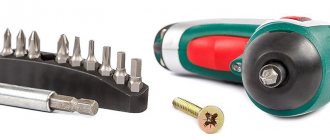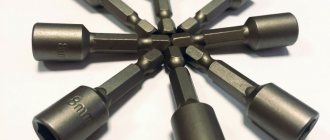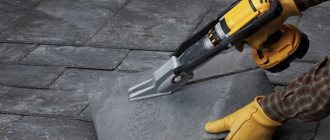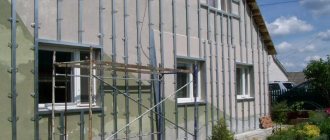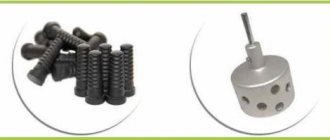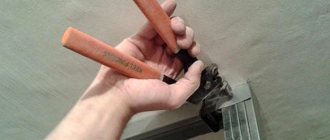When working with drywall, you can easily pinch the self-tapping screw, which causes damage to the sheets of material: cracks appear on the plaster or the cardboard ruptures on the outside. In some cases, the cap may go right through the gypsum board, and as a result the sheet will not be pressed against the profile. In any case, due to pinching, the entire structure noticeably loses strength and reliability. A drywall bit with a stopper will avoid these problems.
What it is?
A bit for working with plasterboard with a limiter is a special attachment for a drill. It is used to prevent the self-tapping screw from being pinched when tightening with a screwdriver. The bit has a stopper that resembles an inverted cup; it is wider than the head. When twisted, it rests against the leaf and prevents the cap from going deeper into the body of the leaf.
This limitation allows the master not to fear that the self-tapping screw will be overtightened. But you won’t have to tighten it up again, since a bit with a drywall limiter allows you to tighten all the screws tightly enough and deepen them to the required level. As a result, the speed of work is significantly increased, since there is no need to waste time on control and inspection. The only thing that is required is minimal skills in working with power tools, because the screws will be screwed in using a screwdriver.
Depth limiting bits are available for a variety of material types. When purchasing, you need to pay attention to the labeling. The nozzle must be designed specifically for drywall, otherwise there is a risk that the material will be damaged. You also need to pay attention to ensuring that the markings of the bit and the heads of the screws match. Otherwise, the work will be uncomfortable, and the risk of damage to the screws, attachments, and even the power tool itself will increase.
The sockets marked PH 2 are suitable for standard black 3.5 mm drywall screws with a Phillips head.
Bits and Sockets Guide. Marking of all sockets and bits
Straight slot bits (SL)
A slotted slot (SL) is a simple recess for a flathead screwdriver.
It looks like a slot made in the head of a screw or self-tapping screw. A distinctive feature of a straight slot is the small contact area between the tool and the fastener (when the bit or screwdriver rotates, its edges touch the inner surface of the slot at only two points). Therefore, the SL (or Slot) flat slot is completely unsuitable for tightening fasteners with high torque. Despite its simplicity and versatility, it is used less and less these days (mostly only for tasks that do not require a lot of tightening force). Spline bits are found in almost every set of replacement bits, including the most budget ones. In the marking they are designated by the letters SL and numbers indicating the width of the blade in millimeters. In everyday life, it is useful to have at least two or three bits with a width from SL4 to SL8 (and flat screwdrivers of small and large sizes are usually needed only by specialists).
Phillips bits (PH, PZ)
Phillips-head fasteners and corresponding screwdrivers for them appeared in the 30s of the last century, when the characteristics of flat-head screws were no longer suitable for the engineering industry. A cross-shaped slot in the “head” of a screw or self-tapping screw allows you to accurately center the tool, and four planes of contact between the Phillips screwdriver or bit and the inner surface of the slot ensure the transmission of increased torque. Therefore, fasteners with cross-shaped slots can be tightened with much greater force without fear of “licking” the head or damaging the tool.
There are about a dozen varieties of Phillips splines, but in practice only two are used: Phillips (PH) and Pozidriv (PZ).
The PH cross recess has been developed specifically for pneumatic and electric screwdrivers. It looks like a cross-shaped slot with a slight thickening in the center. The corresponding bits and screwdrivers are marked with the letters PH and numbers indicating the size: 0000, 000, 00, 0, 1, 2, 3 and 4. Most often, the sets include bits in sizes PH1 to PH3, and the rest may be needed only for highly specialized tasks.
The PZ cross spline is visually different from the PH. Additional “whiskers” are visible on the surface of the Pozidriv slotted fastener head, and corresponding “ribs” are visible on the PZ bits. These additional elements allow even more torque to be transmitted than the PH spline. Screwdrivers and bits of this type are marked with the letters PZ and a numerical designation of the size: from 0 to 5. The type most needed on the farm is the PZ2 bit (almost all Pozidriv type screws that you may encounter in everyday life or at a construction site will be of this size ).
Despite their external similarity, cross tips of different standards are not completely interchangeable. The fact is that the edges of the Phillips slot are slightly beveled at a slight angle, and the internal surfaces of the cross slot of the Pozidriv standard are vertical. Because of this feature, PH type tools tend to be pushed out of the slot under high torque conditions, while PZ bits do not have this drawback. Therefore, although PH bits can be used to tighten PZ fasteners (but not vice versa), it is still better to use the appropriate tool for each type of fastener.
Bits for square and hexagonal slots (SQ, Hex)
Quad and hex splines appeared as an alternative to Phillips splines when it became necessary to increase the torque when tightening screws without increasing the size of their heads.
SQ (Square) bits for Robertson slots have a tip of the working part in the form of a square profile. Their markings indicate numbers indicating the size (from 0 to 4). Screws and self-tapping screws with square slots are not common, but you may need SQ bits if you do auto repair (especially Canadian-made ones) or carpentry. The most useful square bit sizes are SQ2 and SQ3.
Hex bits (Hexagon, Allen) for Allen slots have a working part in the shape of a regular hexagon. The corresponding fasteners are used very widely, especially in the furniture industry. Even ordinary plastic windows are adjusted using hexagons (but special elongated keys are usually used for this). Bits of this type are designated by the letter H and numbers indicating the size (the distance between opposite edges). In everyday life, the most useful and in demand tool is the size from H3 to H6. There are also “anti-vandal” bits HH (Hex Hole, Hex Tamper Resistant or Hex Tamper Proof) with a hole in the center.
Torx bits (T, TX, TH)
Star spline fasteners and tools for working with them came into use more than 50 years ago, when complex equipment and industrial robots appeared on automotive assembly lines. The six-pointed star shape significantly increases the contact area between the bit and the slot. This allows you to tighten fasteners with very high force without damaging the head and working edges of the tool. There is almost no tendency to push the bit out of the slot, so the screwdriver or screwdriver does not need to be pressed axially during operation.
Nowadays, star fasteners can be found anywhere - from laptops to cars. There are several different standards, but the most common are the usual Torx slot (a recess in the form of an asterisk with six rays) and its “vandal-proof” version Torx Security (exactly in the middle of the slot there is a small protruding pin; to work with such fasteners you need a bit with an appropriately sized hole ).
Torx bits are marked with the letter T (for some manufacturers - with the letters TX) and numbers indicating the size: from T1 to T100. The most popular sizes are T10, T15, T20, T25 and T30. Small bits (from T2 to T4) are needed only by those who repair computer equipment and consumer electronics. The marking of Torx Security bits (may also be called Torx Hole or Torx Tamper Resistant) indicates the designation TH (sometimes TR), and their size range is completely identical to Torx bits. The Torx Security tool can be used to work with Torx fasteners (but not vice versa).
Bits for Apple equipment (P)
Screwdrivers and bits designed for tightening and unscrewing screws with slots in the form of a five-pointed star with rounded edges became popular a little more than 10 years ago thanks to Apple. It was then that “vandal-proof” Pentalobe standard fasteners began to be used for assembling MacBook laptops, iPhone smartphones and iPod players. Tool manufacturers immediately began producing screwdrivers and bits for fasteners of this rare standard, and now it is not at all difficult to buy bits for disassembling Apple equipment.
In tool catalogs, Pentalobe bits are designated by the letter P and numbers indicating the standard size. Those who repair electronics may need tools ranging from P1 to P6 sizes. Please note that some bit manufacturers use different letter designations (TS or PL), and the size range of these bits does not correspond to the values accepted by Apple (for example, P2 is TS1, and P5 is TS4). Also, do not confuse Pentalobe bits with the five-point type of Torx slot, because these are completely different standards and are incompatible with each other.
Rare and special bits
In addition to the bits and attachments needed to work with common flat, Phillips and star splines, there are also a large number of special bits that are used for tightening and unscrewing rare types of fasteners.
Spline bits have a working part in the form of a twelve-pointed star with 60-degree angles at the top of each beam. This design allows you to transmit very high torque. Therefore, 12-point sprockets are used where the highest possible tightening force is required (for example, in the automotive industry for engine assembly). The Spline bits are marked to indicate the size of the fastener they are intended to work with (from M5 to M20). Twelve-pointed stars should not be confused with "double hexagons" and "triple squares" (XZN). Despite the fact that they all have the same number of beams, they are incompatible with each other due to different profile geometries.
Tri-Wing bits are bits with three blades, each slightly offset from the center of the slot. The advantage of this design is the transmission of torque without axial pressure. Previously, Tri-Wing spline fasteners were only used in the aerospace industry, but in recent years many appliance manufacturers have been using them as "vandal proof" protection against users. Therefore, you may need three-blade bits in sizes TW0 to TW5 for assembling and disassembling some types of equipment and electronics (and large bits from TW6 to TW15 are useful only if you are engaged in aircraft maintenance). Tri-Point (or Y-Type) bits can sometimes be confused with Tri-Wing bits - they also have three working edges, but the blades are not offset relative to the slot.
Torq bits (Torq-Set) are four-bladed cross bits with an offset center. This slot is extremely rare (mainly in aviation), but can sometimes be used as a “vandal-proof” solution. Torq bits are marked with the letters TQ and a numerical size designation (from 0 to 10). Some tool manufacturers use the letters TS.
Triangle bits are nozzles with a working profile in the shape of a regular triangle. Triangle screws are not often used, but they are sometimes used to block access to the motor or battery compartment of household appliances. Triangular bits may be designated by the letters TR or TA. The most popular sizes are TR2 and TR3.
Clutch bits are essential for tightening and loosening screws with butterfly or hourglass slots. Fasteners of this type are used extremely rarely in Europe, but in the USA they are much more common. Clutch bits are marked with the letter C and numbers indicating the size: conventional (like C1 or C3) or in inches (for example, C1/8″ or C5/32″).
Spanner bits are fork wrenches with two prongs. Screws of this standard are used to protect against unauthorized access. They are used to secure elevator panels or block access to electrical panels in trains and public places. Spanner bits are marked with the letters SP and numbers indicating the size (SP1 to SP10). This tool has many names. Manufacturers may refer to these bits as U-type, Snake-Eyes, Two-Hole, Twin-Hole or Pig-Nose.
Hook bits are quite rare attachments. They are not found in every set. There is no single standard for hook screw bits, so they look different from one manufacturer to another. This bit can be shaped like the letter Y with a groove enclosing the surface of the hook, or it can be made in the form of a cylinder with a transverse slot.
Hex socket heads
Hex sockets are the most common type of socket sockets. Their profile provides good coverage of bolts and nuts. The size range and markings are exactly the same as for regular wrenches. The depth of the standard head is at least 25 mm, and the extended ones have a working part length of 50 mm. For small heads, the seat square is usually 1/4" in size (but as the working size of the tool increases, the counter part also increases: 3/8", 1/2", 3/4" and 1").
Twelve-sided socket heads
Twelve-sided heads, as the name implies, have a profile with 12 working edges. They are distinguished by more precise and convenient positioning on the fastener, because the 12-sided nozzle can be adjusted with a rotation of only 30 ° (as opposed to 60 ° for 6-sided ones). But there is also a drawback: due to the reduced contact area, heads with 12 edges are more prone to “licking” bolts and nuts, especially when it comes to small fasteners. The dimensional grid of twelve-sided socket heads is completely identical to the hexagonal nozzles.
Surface/Super Lock sockets
Surface or Super Lock heads correspond in size to hexagonal nozzles, but differ from them in profile shape. Their internal surfaces are not straight, but slightly convex. Therefore, when rotating, the head does not press on the very corner of the fastener edge, but a little closer to the middle. This design feature allows you to use Super Lock heads to tighten and unscrew slightly “licked” or deformed bolts and nuts.
Torx sockets
Torx sockets (sometimes called E-profile sockets) are similar to the bits of the same name. The inner surface of this instrument has the shape of a six-pointed star. Torx sockets cannot be used to turn conventional hexagonal fasteners, but they are ideal for tightening and unscrewing E-profile bolts and nuts, which are increasingly found these days in the design of cars and some other types of equipment.
Spline sockets
Spline sockets are the most versatile socket type available. They have alternating straight and rounded edges, which (if the head is properly sized) provide good contact with various types of fasteners. With a set of Spline sockets at your disposal, you can twist regular hex bolts and nuts (not only metric, but also inch), as well as Torx fasteners and even three-, four- and twelve-point fasteners.
Selection rules
To choose the right bit, you need to consider the following points:
- Screw diameter. The standard size of the self-tapping screw head for drywall is 3.5 mm; the corresponding PH 2 nozzle must be used for them.
- If the screw heads have an eight-ray slot - a cross-shaped recess with four shallow additional beams - then PZ standard bits are used. The device is selected taking into account the size of the cap.
- Bit length. If the work is carried out in convenient conditions, then a long nozzle is not needed; if the work is carried out in hard-to-reach places, then a longer bit may be needed. They are usually used to create shelves, niches and other architectural elements.
USEFUL INFORMATION: What you can make from plasterboard with your own hands: a dressing room made of plasterboard in the bedroom
- The durability of a tool depends on what alloy it is made of. The most reliable alloys are chromium with vanadium, tungsten with molybdenum and chromium with molybdenum. A bat made from one of these alloys is guaranteed to last a long time.
- Particular care should be taken to inspect attachments made in China, since the percentage of defects even among chrome-vanadium alloys is the highest here.
- A small magnetic holder in the bit will allow you to hold the screws on the end of the bit, so you don't need to hold them and they won't fall. This will greatly simplify the process of assembling a plasterboard structure.
It’s easy to check the quality of the holder magnet: after dipping it into a pile of screws, at least 3 fasteners should stick to the bit. If less, then the magnet strength is insufficient for convenient operation.
- The bit is selected only after the screws have been purchased; it must match the fastening elements, and not vice versa.
Additional coatings increase the service life of the product: nickel protects against corrosion, titanium protects against various mechanical damage, diamond coating makes the bit wear-resistant, and tungsten and carbide add strength.
Fasteners for a Phillips screwdriver and a bit - PH (Phillips) and PZ (Pozidriv).
Screws
1. Screws with lens-shaped cylindrical head and Phillips recess PH, PZ: DIN 7985, GOST 17473-80, EN ISO 7045.
Table 7
| Thread diameter, d , mm | M1.6 | M1.8 | M2 | M2.5 | M3 | M3.5 | M4 | M5 | M6 | M8 | M10 |
| Head diameter, dk , mm | 3,2 | 3,5 | 4,0 | 5,0 | 6,0 | 7,0 | 8,0 | 10,0 | 12,0 | 16,0 | 20,0 |
| Phillips screwdriver size (number) | 0 | 0 | 1 | 1 | 1 | 2 | 2 | 2 | 3 | 4 | 4 |
2. Countersunk and semi-countersunk head screws PH, PZ: DIN 965, GOST 17475-80, EN ISO 7046 and DIN 966, GOST 17474-80, EN ISO 7047.
Table 8
| Thread size, mm | M1.6 | M1.8 | M2 | M2.5 | M3 | M3.5 | M4 | M5 | M6 | M8 | M10 |
| Phillips screwdriver size (number) | 0 | 0 | 0 | 1 | 1 | 2 | 2 | 2 | 3 | 4 | 4 |
Self-tapping screws for sheet metal
1. Self-tapping screws with a semicircular head for a Phillips screwdriver (bit) PH and PZ: DIN 7981, GOST 10621-80, EN ISO 7049.
2. Countersunk screws for a Phillips screwdriver (bit) PH and PZ: DIN 7982, GOST 10619-80, EN ISO 7050.
3. Semi-countersunk screws under the cross PH and PZ: DIN 7983, GOST 10620-80, EN ISO 7051.
Table 9
| Self-tapping thread diameter, mm | 2,2 | 2,9 | 3,5 | 3,9 | 4,2 | 4,8 | 5,5 | 6,3 |
| Phillips screwdriver size (number) | 1 | 1 | 2 | 2 | 2 | 2 | 3 | 3 |
Wood screws
1. Round head screws, slotted PH, PZ: DIN 7996.
2. Screws with countersunk and semi-countersunk heads, slot PH, PZ: DIN 7997, DIN 7995.
Table 10
| Screw thread size, mm | 2 | 2,5 | 3 | 3,5 | 4 | 4,5 | 5 | 5,5 | 6 | 7 | 8 |
| Phillips screwdriver size (number) | 0 | 1 | 1 | 2 | 2 | 2 | 2 | 3 | 3 | 3 | 4 |
3. Universal screws for wood, drywall with PH and PZ slots (black, yellow, galvanized)
Table 11
| Thread diameter, A , mm | 2,5 | 3,0 | 3,5 | 3,8 | 4,2 | 4,5 | 4,8 | 5,0 | 6,0 |
| Screwdriver size (bits) Ph/PZ, number | 1 | 1 | 2 | 2 | 2 | 2 | 2 | 2 | 3 |
Features and Benefits of Using a Restriction Bit
A nozzle with a limiter is a necessary thing when working with drywall. It gives the master very important advantages - speed and quality of work. Since there will be no damage to the sheet, the rigidity and reliability of the structure will increase. However, the advantages of using a special bit do not end there:
- Regardless of the force value set on the screwdriver, the risk of the plasterboard passing through is reduced. This is especially important for novice craftsmen who are not yet accustomed to the tool and do not know what force is enough to tightly tighten the screws, and what will be excessive.
- All the caps are immediately flush with the drywall, nothing sticks out or rises above the surface.
- The price is more than affordable: a high-quality device can be purchased for around 200 rubles. Using a limiter will pay for itself very quickly, because due to damage you will not have to replace sheets of material with new ones.
USEFUL INFORMATION: Plasterboard or suspended ceiling, which is better and cheaper?
A special attachment is necessary for correct and high-quality work with large volumes of drywall. It makes the work better and faster.



